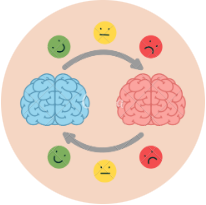STEP:
Skills To Enhance Positivity
Principal Investigators: Shirley Yen, PhD, & Tony Spirito, PhD
The STEP intervention, funded by the NIH, is a brief adjunctive intervention that aims to reduce adolescent suicide risk and depression. Based on the Broaden-and-Build theory of positive emotions (Fredrickson, 2004), the intervention is designed to increase attention to positive affect. Through a series of emotion-focused exercises, STEP helps teens focus on “small-bite” attention shifting exercises, rather than changing the way teens see things. STEP is a technology-enhanced intervention that combines in-person sessions with follow-up text messaging to reinforce positive affect skill use in real-world settings. We strive to build attention, agency, and affiliation.
Intervention Structure:
In-person phase: Four individual sessions, the first covering the rationale behind the intervention – the evolutionary function of positive and negative emotions, our inherent biases towards negativity, and how to shift attention to positive experiences without dismissing the negative. These sessions introduce practices such as mindfulness meditation, gratitude, and savoring positive experiences. We encourage individualization of practices (not everyone likes the same way of practicing mindfulness!) as well as practices that strengthen a social bond.
Remote delivery phase: Daily text messages are sent to encourage mood monitoring and practice of the exercises learned during the intervention period. Participants can choose what type of exercise to practice. Texts are sent daily for the first month, and taper down to every other day. The goal is for everyone to develop their own personal practice into a daily habit, akin to physical exercise.
STEP Research Highlights
-
Open Development Trial (NIH funded trial : R34MH101272)
In an initial pilot study with 20 adolescents admitted to the psychiatric inpatient unit, STEP showed promising results, with an average attendance of 81%, mean daily response to text messages approximately 74%, and with 100% of adolescents rating the STEP intervention as good to excellent. Engagement in suicidal behaviors was less than expected when compared to naturalistic studies.
-
Pilot Randomized Controlled Trial (RCT): (NIH funded trial: R34MH101272)
In a pilot randomized controlled trial of STEP with 52 adolescents admitted to the psychiatric inpatient unit, participants completed an average of 83% of the sessions and engaged with the text-messaging component on 70% of the days, indicating high feasibility and engagement. In addition, over a 6-month follow-up period, participants in the STEP program reported fewer suicidal events compared to those receiving enhanced treatment as usual (6 events vs. 13 events), suggesting potential efficacy in reducing suicidal behaviors. highly, with satisfaction ratings averaging between good and excellent.
-
Fully-powered RCT (NIH funded trial: R01MH123556):
A hybrid type 1 effectiveness-implementation multisite randomized controlled trial is currently under way to examine the effectiveness of STEP as an adjunctive intervention to reduce suicide events, active suicide ideation, and depression in youth admitted to a psychiatric inpatient unit due to suicide risk.
Findings to date indicate that the STEP intervention is a promising approach to enhancing positive affect and reducing suicidal behaviors in high-risk adolescents and young adults. Further research with larger samples that is underway will confirm its effectiveness.
STEP:
Skills To Enhance Positivity
What is STEP all about?
Functions of Positive/Negative Emotions
Both positive and negative emotions have important evolutionary functions. But there’s a natural human tendency for people to put more focus on negative emotions - this tendency is called a “negativity-bias”. Deliberately focusing on positive emotions has been proven to encourage social support, creative problem solving, and resilience.
Promoting Positive Emotions
STEP is an actionable process designed to help promote attention to positive emotions and experiences that are often discounted when someone is feeling depressed or anxious. Skills to Enhance Positivity is a tool-kit to help enhance positive emotions and reduce the attention paid to negative feelings. Focusing on positive emotions has been shown to reinforce feelings of well-being.
The STEP Program
We humans are wired to focus on negative feelings and to try to get rid of them. Especially when we’re stressed out!
STEP is about allowing the negative feelings to exist while practicing exercises to increase your attention to positive emotions and experiences.
Mindfulness
The purpose of mindfulness is to quiet your mind by focusing your attention non-judgmentally on the present moment.
Savoring
Savoring helps you create pleasurable moments and make positive emotions last longer. No memory or event is too small to savor!
Gratitude
Research shows that expressing gratitude boosts your energy, hope, empathy, connection, and happiness.
STEP Exercises to practice
Research shows if you practice mindfulness, savoring, and gratitude regularly, you'll be creating positive emotions every day. Soon, it might just become second nature.
Mindfulness
The purpose of mindfulness is to quiet your mind by focusing your attention non-judgmentally on the present moment.
Gratitude
Gratitude is recognizing something good in your life that you can be thankful for. It helps you notice what you have that you can be happy for – a person, a small gesture of kindness from others, a pet, a life situation, etc.
Savoring
Savoring can be done with any activity, conversation, or happy memory. The goal is not to get rid of or deny the negative but to make just as much space for positive emotions and experiences.
What comes next?
Text Messages
To reinforce practice, users receive daily automated text messages for one month before tapering off over the next two months. The text messages prompt the user to practice the exercises they learned.
Follow-Up Appointments
About 3, 6, and 12 months later, STEP staff will reach out to you to set up a time to meet and do a follow-up assessment. No worries if you can't meet in person. These follow-up appointments can be done remotely. (The only thing is that because you won't be able to complete one of the tasks remotely, you won't be paid for that task if a follow-up ends up being remote.)






